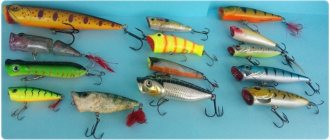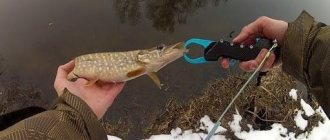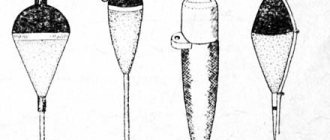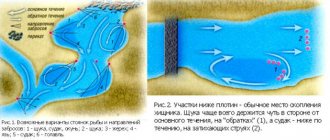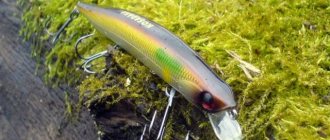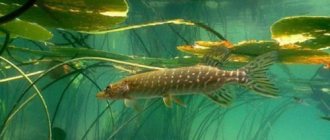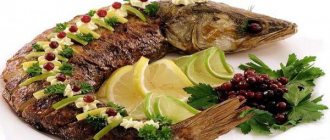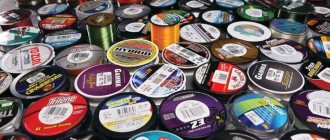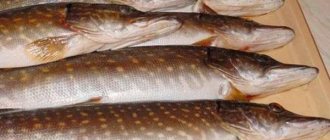Pike is a voracious river predator that can be fished all year round. Its greed and aggressiveness prompted fishermen to create many variations of artificial baits. One of the most popular inventions for catching pike with a spinning rod is a wobbler. Over its more than century-long history, fishing for pike with a wobbler has taken its rightful place among anglers from all over the world. I have acquired many varieties and some special fishing techniques.
Photo: Wobblers for pike
How to catch pike with a wobbler
The key to successful fishing of this type is not only the correct choice of gear, but also a good knowledge of the characteristics and capabilities of your lures. Despite the huge number of models, wobblers can be classified according to several general characteristics.
By immersion depth:
- superficial;
- subsurface;
- deep-sea.
By buoyancy:
- floating
- drowning
- suspenders (according to the manufacturer’s plan, such baits should hold quietly and hang in the water column)
Finally, according to design, wobblers are divided into bladed (minnow, shad, fad, crankbait, crawler) and bladeless (poppers, stickbaits, rattlins, propbaits, jerkbaits, walkers).
For confident fishing, it is enough to have 5-7 wobblers for different occasions. For example, minnows imitate fry as realistically as possible and are excellent for summer fishing, and in the fall it is better to use cranks, especially in rivers and reservoirs.
The optimal wobbler size for pike fishing is 7-12 cm.
You will also need a certain rod - a fast-action spinning rod with a fairly rigid, well-responsive tip and a reliable butt. For fishing from the shore, a rod 2.4 m long is sufficient.
More information about fishing for pike using spinning wobblers in the video:
Features of the tackle
In the modern world there is a huge variety of gear for pike fishing. Once in a fishing store, you can choose for a long time from the whole variety of offers.
The most popular tackle is spinning. When choosing a spinning rod for this predator, you need to be guided not so much by cost as by the correct characteristics.
Rod
The selection of a fishing rod should begin with choosing the optimal length. It depends on the fishing method. If you fish from the shore, then there is a need for long casting.
Accordingly, in order to cast the bait far, they choose a longer option, on average about 3 meters. When fishing from a boat, the issue of casting is not so pressing, so you can buy a shorter model, 2.1 - 2.4 meters.
The next thing you need to pay attention to is the material from which the rod is made. Professionals recommend purchasing carbon fiber tackle. Of course, you can choose other composite materials, for example, fiberglass, but they will not provide the required quality.
A rod with a test weight of 5-25 grams is ideal for all beginning fishermen. It is suitable for installing any baits:
- rotating and oscillating spoons;
- wobblers;
- jigs, etc.
With more experience, you will be able to select other fishing rods to suit your individual characteristics.
Coil
When selecting a coil, it is also necessary to take into account several parameters:
- body material;
- spool size;
- friction brake;
- bearings;
- gear ratio.
First you need to decide on the material of the case. You should not buy reels made of cheap plastic, because they can easily break during pike fishing. It is better to choose carbon, aluminum, or graphite options. The size of the drum (spool) is also important; you need to pay attention to the markings. It shows what line should be wound on the spool and what length.
Tips for fisherman: What gear is needed for pike fishing - What is the difference, pros and cons
The friction brake is needed to prevent large prey from easily unwinding the line on the spool. There are two types of brake: front and rear. Their operating principle is approximately the same, only the location is different. Its presence is extremely important for catching large pike specimens.
For some, the presence of bearings is a sufficient argument for buying a reel, while others want a large number of them. Their very presence is a sign of good quality and long service life.
fishing line
The variety of types of fishing line makes modern fishermen's eyes run wild. Pike fishing involves taking into account some parameters:
- color;
- thickness;
- strength;
- material.
Of course, you shouldn’t attach much importance to what color fishing line you use, however, professionals recommend following the recommendations. When using an oscillating spoon, it is better to choose a gray or marsh-colored fishing line.
If you use a jig, it is better to choose bright colors. If you need to control the wiring, it is better to use luminescent types (white or pink).
The thickness varies depending on the type of fishing for the “toothy” predator and the personal preferences of the fisherman. Typically, the optimal diameter is in the range of 0.12 -0.2 mm when fishing with small baits, and 0.3 mm when fishing with large baits. For pike fishing, a fishing line that can withstand 8-9 kg is usually enough.
The main materials used for the production of fishing lines are:
- monofilament;
- network;
- fluorocarbon.
Leash
There are a large number of leashes. Each has its own advantages and disadvantages:
Equipment
All selected components of the spinning rod must be fully compatible with each other so as not to get into an awkward position while fishing. The tackle set must be designed for a certain size of pike. It shouldn’t turn out that the rod and leash are designed for a “river giant”, and the line for a fry.
This is a natural clock that is worth listening to. They are much more reliable than biting calendars.
The principles for searching for pike sites in the spring vary depending on the type of reservoir and are as follows:
1. On the rivers
the predator usually hides under steep banks and can grab the hook at the end of the retrieve. Therefore, it must always be brought to the very end. If the river is small in width, it is better to throw bait on the opposite bank. Pike can grab them right away. In the spring there is no predator in a strong current, since it does not have the strength to fight the movement of water flows.
2. On deep lakes
At the beginning of spring, pike are found on shallows located along the shore, on shallow ones - under the shore, on underwater mounds. When the water warms up well, it will go further into the depths, into holes and ditches.
3. On the ponds
The predator stands near vegetation in any season, in snags, under flooded logs, in windows and corridors of aquatic vegetation.
4. On spacious reservoirs
In spring, pike prefers the coastal zone. At this time, carp species of fish spawn in the grass near the shore. The predator feeds on them. It goes to a shallow depth of only 30 centimeters to grab prey.
If fishing is done from a boat, it is necessary to fish shallow waters using light spinning rods with a flexible tip. When fishing from the shore in the spring, places up to 1.5 meters deep are selected, where there are shelters. For this purpose, blanks from 2.2 meters to 2.7 meters long, medium-fast and parabolic action with dough up to 20 grams are suitable. Equipment
you have to choose like this:
1. Inertia-free reel with sizes from 2300 to 3000. They must have a small additional bearing number. This will ensure faster catching of prey and increase the reliability of the reel.
2. Monofilament fishing line with a diameter of 0.2 to 0.24 millimeters. A braided cord with a thickness of 0.07 to 0.12 millimeters is also suitable.
3. Leashes. For pike fishing in the spring they are required. The best solution would be do-it-yourself twist leashes made from guitar strings. Their connection to the fishing line does not require additional elements, which often scare away the fish. The length of such leashes ranges from 15 to 20 centimeters.
In spring, a lot of pike can be found in the water meadows. Fish come to them with floods in search of a place to spawn. When the water subsides, the pike finds itself isolated from the main part of the reservoir, experiences a shortage of food and greedily rushes to any bait.
Individuals that have reached sexual maturity reach an average length of 50-100 cm. Thirty-year-old specimens can sometimes reach one and a half meters in length and weigh over 20 kilograms.
The best color of wobbler for catching pike
We must immediately make a reservation that there is no wobbler color that is guaranteed to provoke predatory fish. When choosing gear, it is necessary to take into account the weather, time of year, water transparency and fishing location. You will have to experiment often, even within the same body of water. The only universal rule is that the wobbler should be as noticeable as possible.
In clear weather, when the sun's rays clearly illuminate the water column, it is better to choose dark colors, such as “olive”. On cloudy days, on the contrary, you need to use light colors. Wobblers with bright, acidic colors perform well in muddy water.
Types of wobbler wiring
There is no universal wiring for pike fishing, however, several methods can be distinguished:
| # | Wiring type | Peculiarities |
| 1 | Uniform | The simplest wiring, after casting, wait until the wobbler dives to a certain depth, you need to start winding the fishing line. The method is simple, but the result greatly depends on the performance of the wobbler itself. |
| 2 | Stepped | After casting, you need to wait until the tackle is at depth and make a couple of turns of the reel. After that, lightly but sharply pull the spinning rod, so the wobbler will quickly rise in the water column, attracting the attention of the predator. The main thing in such wiring is to try to keep the tackle within the required depth. |
| 3 | Aggressive | This type of wiring differs from the stepped one only in the sharper movements of the rod. |
| 4 | Demolition | For drift fishing, you need to choose a place with a good, even current. A suspended wobbler is used, which hangs in the water column at the same depth. After casting, the current should carry the suspender away, providing animation without effort on the part of the fisherman. |
| 5 | Stop and go | After casting, you need to slowly make a few turns of the reel, wait a while, then sharply jerk the tip of the rod. Often the fish bites during a pause, so the jerk can also become a hooking movement. |
| 6 | Twitching (twitch) | This is quite a dynamic, flexible and exciting wiring. The bait moves in the water due to jerks with the tip of the rod and subsequent pauses. Twitching imitates the behavior of prey well, so predatory fish willingly join the game and grab the bait. In addition, twitch allows you to experiment with the strength of jerks and the frequency and duration of pauses. This way you can depict both active fish and sleepy fry, depending on the fishing conditions. |
About
Hooking and landing pike
The pike grabs the bait with acceleration and finds itself on the rod with a sharp push, which must be immediately followed by a hook, otherwise the bait will be spat out. Small and medium-sized pike can be dragged without much effort by constantly winding the line onto the reel and keeping the line under tension. But a large predator needs to be fished out, and sometimes it is necessary to release the fishing line with a correctly adjusted reel clutch and lower the tip of the spinning rod into the water to avoid the toothy one jumping out of the water.
It is also necessary to keep in mind that a predator often grabs the bait at the moment when the spoon or wobbler is taken out of the water to re-cast, and therefore this must be done slowly. It happens that a toothy predator even grabs a spoon on the fly at the moment of casting. When searching for a toothy predator, you should not throw in one place more than two or three times, since the toothy predator usually grabs the bait the first time. And if she doesn’t take it, it’s better to change the bait to a pike, because the bait offered to her earlier didn’t interest her.
Tips for a fisherman: How to choose a spinning rod for pike fishing - Tips for a beginner
When brought to the boat or to the shore, the caught toothy predator must be pulled out of the water with a landing net, because it usually twitches until the last moment. And it especially hits at the last moment, as soon as she sees the fisherman pulling her towards him. And if you take it with your hand, it can twitch and slip out, and with its teeth you can damage the fisherman’s fingers; such wounds then take a very long time to heal.
Crank is a fundamentally different bait. This wobbler has the shape of a pot-bellied barrel and is most often driven evenly. It’s not for nothing that Americans call the method of fishing with cranks idiot baiting.

